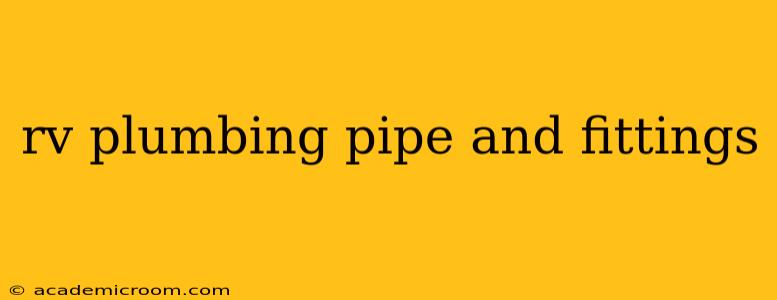Planning a plumbing project for your RV can feel daunting, but understanding the specifics of RV plumbing pipe and fittings makes the process significantly easier. This guide dives deep into the materials, types, and considerations for successful RV plumbing installations. We'll cover everything from choosing the right pipe to tackling common issues, ensuring your RV's plumbing system is reliable and efficient.
What Type of Pipe is Used in RVs?
RVs primarily utilize PEX (cross-linked polyethylene) tubing for their plumbing systems. PEX is a flexible, lightweight material resistant to freezing and bursting, crucial features given the varied climates RVs often endure. Unlike rigid metal pipes, PEX is easier to install, navigate tight spaces, and repair. While some older RVs might have copper or CPVC piping, PEX is the modern standard for its durability and ease of use.
What are the Different Types of RV Plumbing Fittings?
RV plumbing fittings are designed to connect PEX tubing securely and efficiently. Common types include:
- Compression Fittings: These are popular for their ease of installation and reusability. They use a compression ring to create a watertight seal around the PEX tubing.
- Crimp Fittings: These fittings require a specialized crimping tool to securely attach to the PEX tubing. They provide a strong, permanent connection, often favored for high-pressure applications.
- Push-to-Connect Fittings: These fittings are incredibly convenient, requiring only pushing the PEX tubing into the fitting until it clicks into place. While quick and easy, it’s crucial to ensure a proper connection for watertight sealing.
The choice of fitting type often depends on personal preference, the complexity of the plumbing project, and the desired level of security.
What Size Plumbing Pipe is Used in RVs?
RV plumbing systems typically use ½ inch or ¾ inch diameter PEX tubing. ½ inch is generally sufficient for most applications, including sinks and showers. ¾ inch tubing is often used for the main water line supplying the entire RV, ensuring sufficient water flow. Choosing the appropriate size depends on your specific RV model and the demands of your plumbing system.
How to Repair RV Plumbing Leaks?
Leaks are a common RV plumbing woe, but thankfully, often easily repairable. Before attempting any repair, turn off the water supply. The repair method depends on the location and severity of the leak. Minor leaks from fittings might be resolved by tightening the connections or replacing worn-out O-rings. Larger leaks may require replacing sections of PEX tubing or fittings. Always remember to use appropriate tools and follow manufacturer instructions for safe and effective repairs.
Can I Use Regular Plumbing Pipe in My RV?
While you could theoretically use other types of plumbing pipe, it's strongly discouraged for several reasons. PEX tubing's flexibility, freeze resistance, and ease of installation make it the ideal choice for the constraints of RV living and plumbing. Using rigid or less flexible materials makes installation significantly more difficult and can lead to added stress on the system.
What are the Best RV Plumbing Repair Kits?
Various RV plumbing repair kits are available, typically containing a selection of fittings, tubing, and tools. Choosing a kit depends on your specific needs and the anticipated repairs. Consider kits that offer a range of fitting types and sizes to accommodate diverse situations.
How Do I Winterize My RV Plumbing System?
Winterizing your RV plumbing is crucial to prevent damage from freezing temperatures. This process typically involves draining all water from the lines and adding RV antifreeze to protect against freezing. Consult your RV's manual for specific winterization procedures as they can vary based on model and plumbing setup.
This comprehensive guide helps navigate the world of RV plumbing pipe and fittings. Remember, proper planning and the right materials contribute to a successful plumbing system that ensures comfortable and worry-free RV adventures.
